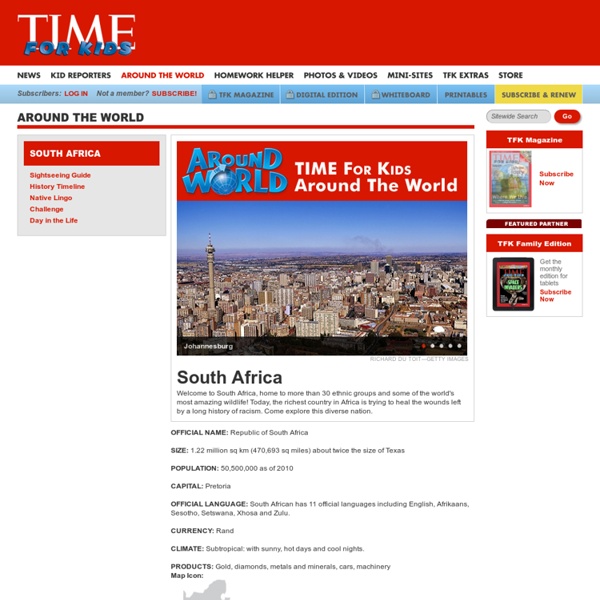



Kids from South Africa | FactMonster.com Continent: Southern AfricaSchool: Children ages 7 through 15 are required to attend school. Parents must pay fees for their children to attend school, even public schools. All students wear uniforms. Schools in South Africa are packed with kids. In fact, some schools have two or three sessions to accommodate all the kids.Play: Soccer is the most popular sport in South Africa. In 2010, South Africa will become the first African country to host the men’s World Cup tournament. For more information, go to the Fact Monster page about South Africa. More on Kids from South Africa from Fact Monster: Homework Center: World - Subjects » Geography » History » Language Arts » Mathematics » ...
All About South Africa Jun 08, 2010 Seeing as the 2010 FIFA World Cup happened in South Africa, we thought it’d be cool to learn a bit more about the beautiful country, which has definitely been through its fair share of tough times. South African Kids Of all the countries on the continent of Africa, South Africa’s the most diverse in terms of its territory. It ranges from rolling hills to wide open savannah to the Kalahari Desert to the high peaks of the Drakensberg Mountains. Lots of people visit South Africa to go on safari, though, since it’s got two of the world’s most famous wildlife reserves: the Kruger and the Kalahari Gemsbok National Parks. Map of South Africa Early History South Africa is a beautiful country. A couple hundred years later, when gold was discovered in South Africa by the British, wars broke out between different European settlers who wanted to gain control of the country for themselves. Apartheid Apartheid in South Africa Nelson Mandela Nelson Mandela Nelson Mandela Freed Nelson Mandela Statue
Ten odd facts about South Africa | Road Travel Africa Here’s ten little known miscellaneous facts about South Africa. South Africa has the longest wine route in the world. The Tugela Falls is the second highest waterfall in the world, where the water tumbles down 2,789 feet. First place goes to the Angel Falls in Venezuela at 3,212 feet. South Africa has the oldest meteor scar in the world, just across the Vaal River near Parys, called the Vredefort Dome. The meteor plummeted to Earth nearly two billion years ago (Earth is said to be 4,5 billion years old), pre-dating the heady days of oxygen and multi-celled life. Watch this space for more odd tit-bits of information about our amazing country.
South Africa — Our Africa The anti-apartheid movement Two teenagers visit a memorial in Soweto where a display photograph shows a father carrying his dead child in his arms. This picture became an emblem of the anti-apartheid movement. A huge divide Average life expectancy in South Africa is 54, though there is a great divide in the standard of living and health among the country's 50 million people. Deserts, rainforests, mountains… South Africa’s varied geography has diverse habitats, including deserts, savannahs, rainforests, mangroves, wetlands and mountain regions. 'The sky's the limit' Two 22 year-old men talk about their future plans and aspirations. Explore South Africa Explore a map of South Africa. Economy has strengthened After experiencing difficult times during the sanctions and isolation of the apartheid era, South Africa’s economy has strengthened since 1994, posting average annual growth of around 3.5% over the past decade. Fish, meat and maize Tables turned on journalist Hero and role model Beads galore